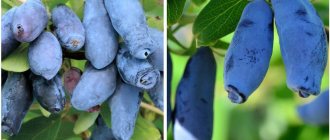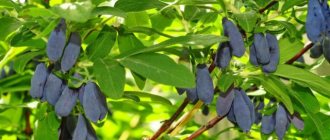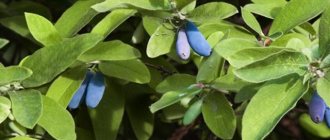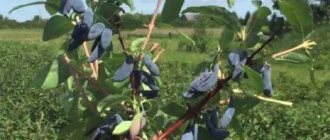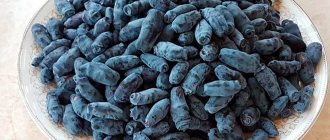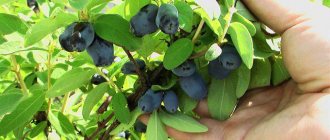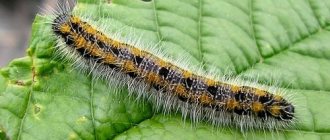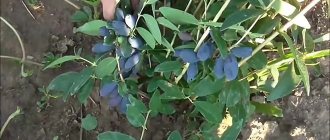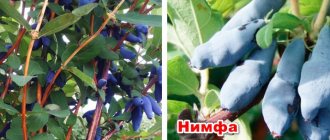Evolution over 80 years. Does this happen? Yes. And honeysuckle Delight is a clear confirmation of this. I can’t even believe that this magnificent hybrid with large, sweet, fleshy fruits that taste like tropical fruits came from a modest northern berry - sour, tart, with noticeable bitterness. The most remarkable thing is that after improving the taste characteristics, the fruit bush retained the features of the Siberian character - endurance, unpretentiousness, the ability to be content with little and survive where many cultivated plants die.
History of selection
Many varieties of edible honeysuckle have been bred in Russia, one of which is the Vostorg variety. The merit of the selection belongs to the northernmost and only nursery in Western Siberia - FSUE "Bakcharskoye", where honeysuckle is considered the leading crop of the economy.
Work on its selection has been carried out since 1964, and in Russia today Bakcharskoye has the largest plantation of this crop - about 50 hectares. Delight is the newest honeysuckle variety bred at the Bakcharskoye Federal State Unitary Enterprise. In 2012 it was transferred to State variety testing. Along with this variety, the varieties Ussulga, Blue Cliff, Uslada, and Lavina are being tested.
How to plant correctly
Honeysuckle seedlings are planted only in autumn. Spring planting is not possible due to the biological characteristics of the plant. Too early in the growing season (at the end of March) does not allow this to be done. Honeysuckle buds begin to bloom at a time when there is still snow in much of the country. And as you know, planting after the start of sap flow in plants reduces the chances of survival to nothing.
In autumn, depending on the region, planting is carried out at the following times:
- August - Eastern Siberia, northern European Russia;
- from the last days of September to mid-October - Western Siberia, the Far East, the Urals and the middle zone of the European part of the country.
Botanical description
Honeysuckle is a berry shrub (Lonicera caerulea) member of the Honeysuckle family that grows without much support in temperate and cool zones in the circumpolar regions of the northern hemisphere. The crop is known as honeysuckle in Russia, haskap in Japan, and Honeyberry in English-speaking countries.
Did you know? Honeysuckle received its Latin
name Lonicera from the name of the 16th century German physician and botanist Adam Lonicer, who described this species in his works.
Edible blue honeysuckle is the precise name for the species in general, and is listed as an official food in the EU under the name "haskap" by order of the European Commission.
Description of the honeysuckle variety Slavyanka
Honeysuckle Slavyanka is considered a valuable plant due to its edible fruits, rich in many nutrients. A big advantage is that the berries ripen very early, faster than strawberries.
Usually the bushes reach no more than 1.5 m in height, so there should not be any problems with their placement.
Honeysuckle of this variety can also be an interesting accent in the garden with a high level of utility. Its decorative character is due, first of all, to its compactness and the rapid onset of the growing season. Perhaps the white-yellow honey-bearing flowers that appear in April and May do not have significant beauty, but in combination with the good shape of the bush, the rapid development of leaves and picturesque purple fruits, they can become a spring decoration for the garden area.
History of selection
This variety belongs to the genus Lonictra L., honeysuckle family, subsection of edible blue honeysuckles (Caeruleae Regd).
Did you know? Climbing honeysuckle, which is grown to decorate gazebos and summer canopies with bright greenery and orange flowers, is very popular among summer residents. The berries of the climbing varieties are inedible and not suitable for consumption.
The honeysuckle variety Slavyanka was bred at an experimental breeding plot in the village of Pavlovskoye, which is supervised by the All-Russian Institute of Plant Growing named after. Vavilova N.I. The variety is the result of crossing Primorsky honeysuckle (elite, sample No. 21–5) and Leningrad giant.
Appearance, characteristics of berries
Honeysuckle variety Slavyanka is an upright, vigorous shrub with strong vertical branches. It reaches a height of approximately 150 cm, the width of the crown occupies a space of up to 1 m. The leaves are small, lanceolate, evergreen, located on both sides of the branches. Small and barely noticeable yellow-whitish flowers appear in April-May; the harvest ripens approximately 40 days after setting.
The fruits are edible, large, oblong, conical in shape, up to 3 cm long, weighing up to 1 g, blue in color with a thick waxy coating. This species tolerates drought well and is very frost-resistant. Their taste can be described as sweet and sour, dessert. With pollinating plants growing nearby, you can harvest from 2 to 4 kg from an adult bush.
For propagation, it is best to use green or lignified cuttings. The first ones are cut off during the period of greatest growth of the crop - in the spring; lignified planting material is obtained in November. Green herbal cuttings are immediately planted in the nursery's planting substrate, while woody cuttings should be stored until spring in a cool and damp place (basement, refrigerator), only after which they can be rooted.
Video: how to cut honeysuckle
In the spring, cuttings are separated from the mother plant after flowering, usually this period occurs in June. Seeds are sown in autumn or spring in small containers; after germination, they are cared for as for ordinary seedlings (the soil is loosened, watered, and, if necessary, illuminated).
Honeysuckle berries contain many active and nutrients (anthocyanins and sugars), vitamin C and minerals (phosphorus, magnesium, iron, calcium, potassium). In folk medicine they are used as a disinfectant and antiseptic, as well as in the treatment of diseases associated with the digestive tract and circulatory system. The presence of anthocyanins and other active substances has a positive effect on human immunity, the body becomes more resistant to illnesses, including cancer. In addition, the fruits have a rejuvenating effect.
The berries can be processed for long-term storage; they are suitable for making juices, jams, and preserves. They can also be dried and frozen. Processed fruits retain most of the nutrients - up to 80%.
Did you know? Landscape designers use seaside honeysuckle shrubs to create plant sculptures. Unusual green shapes are formed from plants using skillful pruning of branches.
Advantages and disadvantages of the variety
Growing these unusual, exotic berries in the garden brings the owner both aesthetic and gastronomic pleasure.
- Advantages of the variety:
- dessert taste and large-fruited berries;
- low maintenance requirements;
- good yield;
- possibility of growing without a garter;
- fruiting for several decades;
- resistance to diseases and insects.
- Disadvantages of the variety:
- long wait for a full harvest;
- the need for regular pruning of adult bushes.
Characteristic
Delight is an early ripening variety with simultaneous ripening of berries. The ripening period is 70 days after pollination (May-June). The bush is vigorous, sparse, oval-shaped crown. Height - 1.7–1.9 m, crown diameter - 1–1.5 m. Shoots are erect, flexible, light green. The annual growth is 60 cm. Old branches are brown, curved at the base. The wood is highly fibrous.
Sometimes sections of the bark on honeysuckle peel off, flake off and expose the branches, which is a feature of the culture. The leaves are opposite, arranged in pairs, oval, 3–8 cm long and 1–3 cm wide, light green with a waxy texture. The flowers are yellowish-white, bisexual, large, 12–16 mm long, tubular, slightly fragrant, appear in March. They are located in pairs in the axils of leaves or at the ends of branches.
Description of the honeysuckle variety Pushkinskaya
Today there are more than two hundred varieties of honeysuckle in the world. About fifty of its species grow on the territory of Russia and Ukraine. Basically, these varieties are not edible. To obtain dessert varieties of this plant suitable for food, since the mid-50s of the 20th century. Breeders are working hard.
History of selection
The Pushkinskaya honeysuckle variety was bred in Russia at an experimental station in the city of Pavlovsk, Leningrad Region, in the 90s of the last century. The work was supervised by Mikhail Vasilyevich Lebedev. The task of the nursery was to obtain zoned dessert varieties of fruit and berry crops, including honeysuckle.
For breeding work, sprouts brought from Kamchatka were used, so the plant is quite squat, with a thick crown, and can withstand frost well. The varieties bred at the Pavlovsk station have the highest sugar content compared to others, but at the same time they have lower levels of vitamins C and P.
Appearance, characteristics of berries, ripening time, yield
The variety grows as a medium-sized bush with thick straight branches. It reaches a height of 1.5 m. The crown is rounded and of medium density. The leaves are bright green, very large and dense, in the form of an oblong oval. Pushkinskaya is an early ripening plant (in May). The berries are large, weighing 1 g, 2 cm long and 1 cm in diameter. They have an oblong-oval shape with a ridge at the top, dark blue in color, with a light coating of wax.
The skin is thin. The taste of the berries is sweet and sour with a predominance of sweet, the smell is pleasant. They are universal in use, have positive consumer reviews (suitable both for consumption raw and for freezing, preparing various jams, fruit drinks, preserves).
Important! When processed at high temperatures, honeysuckle berries do not lose their beneficial properties. Jam made from these fruits is a valuable source of vitamins and microelements in winter.
Advantages and disadvantages of the variety
Honeysuckle Pushkinskaya is a highly adaptive plant, which makes it attractive for cultivation. However, you should know and take into account some features of the variety. Like any garden crop, it has its positive and negative sides:
| Advantages | Flaws |
| High yield - up to 3 kg | Fruit shedding up to 20% |
| High frost resistance - up to –40°С | Does not tolerate heat, prolonged warm autumns and winter thaws (reduces yield and growth of cuttings) |
| Early ripening dates - May in the middle zone | The berries ripen almost all at the same time and can quickly fall off |
| Not susceptible to any diseases | Suffered from pests |
| Dessert sweet and sour taste of fruits | Low shelf life of fruits due to thin peel |
| Unpretentious to soil and climatic conditions | Does not tolerate groundwater near the root system |
Pollinators
The variety Vostorg is partially self-fertile. Since honeysuckle blooms in early spring, when there is no active flight of pollinating insects, to obtain high-quality pollination and, thus, a good harvest, several pollinating varieties with close flowering periods should be planted nearby.
Did you know? The traditional name of the honeysuckle plant,
"ha-shika-pu" in the language of the ancient Ainu (indigenous inhabitants of the Japanese islands) translates as "many gifts at the end of the branch."
The best pollinators for this variety are the Bakchar varieties Yugana, Silginka, Bakcharsky Velikan, Daughter of the Giant, Narymskaya, Roksana, Kamchadalka.
Pollination and pruning technology
For good fruiting, this variety requires cross-pollination. Therefore, at least three plants of different varieties should be planted in one area.
The best pollinating varieties for “Delight”:
- "Silginka";
- "Yugana";
- "The Giant's Daughter"
If you use these pollinating varieties for “Delight,” its berries will be much larger.
The variety produces fruit buds only on young branches, so proper pruning of the bush is very important.
An adult bush should have no more than 18 skeletal branches. All other shoots should be pruned in the fall.
When the plant reaches the age of 15 years, its yield will decrease. At 20 years old, the bush is already considered old. In order for it to continue to bear fruit well, it is necessary to cut off all the branches that did not have berries. Regular rejuvenating pruning is also very useful - during growth, in the summer, old branches are cut off into stumps. In their place, young branches will grow, which will produce a harvest next season.
Landing Features
When planting honeysuckle on your site, you should know that the plant grows slowly, although already in the 2nd year it can bloom and produce several berries. At the beginning of development (the first 2 years), the plant strengthens the root system, the diameter of which usually exceeds the diameter of the crown. This must be taken into account when applying fertilizers and loosening.
Deadlines
Seedlings need to be planted during the plant's dormant period - early spring (March) or late autumn (November), in Siberian conditions - the end of September or the first half of October. The land should be suitable for cultivation, that is, not frozen or swampy.
You will be interested to know why edible honeysuckle does not bear fruit.
Container varieties can be planted with a ball of soil throughout the year, but avoid planting in hot or cold weather. The time frame for spring planting of honeysuckle is very short, since the plants bloom early, so it is best to avoid planting during this period.
Selecting a site, preparing holes
Honeysuckle is so unpretentious that it can grow in fairly deep shade and on all types of soil.
But to optimize the harvest, both in quality and quantity, it is advisable to choose the following areas:
- The soil should be moisture-absorbing, but well-drained and fertilized with organic matter.
- When grown in northern regions, a sunny place where the sun shines for half a day, preferably in the morning (partial shading is acceptable). In the south, protection from the sun is needed, since in direct sunlight the berries become smaller and the leaves may burn.
- Soil type: light sandy or medium loamy.
- The pH level of the soil is not critical - honeysuckle grows in a range from acidic to alkaline soils. But pH levels around 6.6 are considered optimal for berry crops.
- The site should be protected from the wind (better pollination and prevention of berry shedding) and not located in cold pockets and swampy lowlands.
The degree of illumination affects the speed of fruit ripening, their size and sugar content, and also minimizes the risk of fungal diseases. Very deep shade at the planting site leads to a lack of flowering and growth of green mass, and heavy and wet soil or dry places lead to a stunted and sickly appearance of the plant.
Secrets of cultivation
Hybrid honeysuckle Delight can be mastered even by novice gardeners, since growing it does not pose any particular difficulties. You just need to take into account some nuances.
Landing dates
Honeysuckle can be planted in the spring. Moreover, you need to start work before the buds open. Experienced gardeners prefer to propagate the Delight variety in autumn - from the end of September to the second half of October.
Selection of location and soil
Judging by the description and characteristics, honeysuckle Delight is an unpretentious berry bush. But it gives a good harvest:
- In areas that are illuminated and protected from winds.
- In areas where groundwater approaches the surface no higher than one meter.
- On neutral or slightly acidic soils.
- When the root system is in the shade and the crown is well lit by the sun.
Planting a bush
Honeysuckle has its own life cycles, which differ from other plants:
- Winter sleep ends in early spring, and leaves begin to bloom already at the root of March.
- The dormant state begins in the last days of July.
These features must be taken into account when planting honeysuckle. It is best to plant bushes from September to the end of October. In spring, plants will immediately begin their development and will be able to grow their root system and green mass. The distance between the bushes should be at least 150 cm. Honeysuckle grows well next to currants.
Important! 2-3 year old seedlings are selected for planting.
And now about the landing rules:
- The pit is prepared in advance, the depth and diameter is 40 cm or more (depending on the size of the root system).
- Drainage is placed at the bottom. These can be stones, plant branches, bark.
- Add compost (2 buckets), wood ash (1 liter jar) and 3 tablespoons of superphosphate (no more!) to the soil.
- The hole is filled with water, a mound is made in the center, on which a honeysuckle bush is planted, like on a chair. The roots are carefully straightened, soil is added and watered again to compact the soil and remove air pockets. After this, add a layer of mulch. The root collar should not be buried more than 5-6 cm!
- The branches are not shortened after planting so that the growth of the bush does not slow down.
Rules of care
Caring for the crop is not complicated and consists of optimal irrigation, fertilization as needed, seasonal and sanitary pruning, and prevention of pests and diseases. Honeysuckle Delight is moisture-loving, but at any age it does not like stagnant water, but prefers a slightly moist state of the root zone. During the first year, young plantings need regular watering to establish roots, but the top surface of the soil should dry out between waterings. Lack of moisture negatively affects the quality of berries, their crumbling and overall yield indicators.
Irrigation significantly increases fruit weight. Under honeysuckle bushes, around the root zone, it is necessary to lay a layer of organic mulch 5–7 cm thick. Mulching helps prevent the growth of weeds, maintain moisture and coolness, and improve soil fertility. Watering mulch and evaporating moisture increases the humidity around the bushes, which also has a positive effect on the development of the plant. In autumn, the mulch layer is increased to protect against frost.
Important! It should be borne in mind that too much nitrogen fertilizer causes rapid growth of green mass to the detriment of flowering and berry formation, as well as the growth of new shoots on the eve of winter cold.
If honeysuckle is planted in fertile and well-fertilized soil, then in the future it will grow actively without additional fertilizing for 2-3 years. In the spring, adding compost, humus, or low-nitrogen fertilizers stimulates flowering and replenishes the soil with nutrients. Slow growing plants can be fed again in early summer. In late autumn, a 2.5 cm layer of compost or rotted manure is placed under the mulch along the root zones of plants. Meat and bone or fish meal is a good feed additive.
Fertilizers are embedded in moist soil to a depth of 15–20 cm, where the bulk of the root system is located. Young plants only need to remove dead and damaged branches during the first 3 years. On adult bushes, weak shoots that thicken the crown, intersecting branches, and the tips of young shoots are pruned, which helps to increase flowering on the lateral parts. For the purpose of rejuvenation, old bushes 15–20 years old should be cut to a height of 30 cm from the ground. New shoots will appear in the spring, but the season's harvest will be lost.
Honeysuckle Delight - a triumph of Bakchar selection
Evolution over 80 years. Does this happen? Yes. And honeysuckle Delight is a clear confirmation of this.
I can’t even believe that this magnificent hybrid with large, sweet, fleshy fruits that taste like tropical fruits came from a modest northern berry - sour, tart, with noticeable bitterness.
The most remarkable thing is that after improving the taste characteristics, the fruit bush retained the features of the Siberian character - endurance, unpretentiousness, the ability to be content with little and survive where many cultivated plants die.
Northern berry with tropical taste
Having started honeysuckle selection back in the 1930s, Siberian scientists understood what a difficult task they faced. The crop seemed promising, but it had many shortcomings - small sour berries, noticeable astringency and bitterness in taste, low yield, uneven ripening, high fruit shedding.
But year after year, generation after generation, the undesirable features of the bush were methodically displaced, and the attractive characteristics, on the contrary, were nurtured and consolidated.
The triumph of Siberian breeders was the fourth generation hybrid forms of honeysuckle, including the Vostorg variety, bred in the Bakcharsky fruit nursery and shown in the photo above.
It was submitted for state variety testing in 2012.
Advantages and weaknesses of a hybrid
The advantages of honeysuckle Delight prevail in the description of the variety.
- It ripens early (in the first ten days of June) and quickly.
- The size of the berries is one of the largest among the existing assortment.
- The variety is characterized by consistently high yields with maximum values from the 5th–6th to the 15th year of the bush’s life.
- The crop is distinguished by its high winter hardiness and plasticity, allowing it to easily colonize habitats with different climatic conditions.
- The variety is relatively resistant to shedding (no more than 20% of the crop falls off), but is easily separated from the stalk. This allows you to remove the berries by shaking the bush.
- Strong skin, dense pulp, dry fruit separation ensure high transportability of the crop.
- High threshold of resistance to fungal infections and pests.
If we talk about weak points, honeysuckle Vostorg, however, like most Siberian varieties, suffers from extremes and sharp fluctuations in temperatures during the cold season.
What regions is it suitable for?
The hybrid was bred in the environmental conditions of Western Siberia, but due to its high plasticity, it takes root well in regions with a less frosty and less sharply continental climate.
Delight feels good in the Urals, in most of the central zone, but in some years it can suffer from prolonged thaws.
The biorhythms of the plant do not coincide with the mild, humid climate of northwestern European regions.
Features of caring for hybrid forms of honeysuckle
Varieties such as honeysuckle Vostorg have enormous potential and are designed for intensive fruiting. They give a lot every year, but in return they demand decent conditions and good care.
- The crop will bear fruit intensively in the sun. In the shade, the vegetative mass increases, but the yield decreases, and the berries gain sugar worse.
- In the first 2–3 years, it is necessary to build up a powerful root system - the key to abundant and long-term fruiting. This is facilitated by proper planting - in loose, organic-rich soil. Add at least 2-3 buckets of humus, 80-100 g of superphosphate, and a liter jar of wood ash. If groundwater is close, be sure to provide drainage.
- After fruiting begins, the plant will intensively consume nutrients. They need to be replenished. The best option is annual organic feeding - dry (adding the bush with humus in the winter) and liquid (with a solution of mullein, chicken droppings in the spring).
- Honeysuckle Delight loves watering. With a lack of moisture, the berries become smaller, become less juicy, and a bitter taste may even appear. You should not forget to water the bushes even after the plant bears fruit. At this time, the harvest for the next year is being planted.
- To better retain moisture, it is recommended to mulch or sod the root zone of the shrub.
If you still think that honeysuckle is a low-yielding crop with a mediocre taste, the Vostorg variety will irrevocably change your idea of the first summer berry.
Honeysuckle variety Delight:
Harvesting and storage
Honeysuckle berries usually ripen in late May or early June, 4–6 weeks after flowering. Fully ripe berries are purple inside and have a complex blueberry-raspberry flavor with a hint of black currant. Fruits picked too early are more sour. When picking, try not to crush the ripe fruits. They can be picked by hand one berry at a time or shaken from the branches onto a cloth laid under the bushes.
We advise you to find out how long honeysuckle can bear fruit.
Harvesting is possible in one go due to the simultaneous ripening of the berries. Honeysuckle is great for fresh consumption and for making juices, jams or wine. It tolerates freezing well - can be stored in a freezer for up to 12 months without loss of nutritional and taste qualities.
Advantages and disadvantages of the variety
Honeysuckle Berel
Like any plant, Delight honeysuckle has its own advantages and disadvantages. Positive qualities include:
- early fruit ripening;
- friendly return and large berry sizes;
- high productivity;
- undemanding and unpretentiousness of the bush;
- excellent frost resistance;
- the fruits do not fall off the bush for a long time;
- the berries are removed from the branches without much effort;
- the crop is suitable for long-term storage and long-distance transportation;
- increased resistance to many diseases and pests.
Honeysuckle Delight berries ripen together and do not fall off the bush for a long time
Honeysuckle variety Vostorg has no particular disadvantages. The only thing that gardeners note in their reviews is that overripe fruits tend to partially crumble. In spring, flowering shrubs may suffer from recurrent frosts.
Honeysuckle berries of the Delight variety contain useful substances that improve cardiac activity and help cleanse the circulatory system. It is very easy to grow this unpretentious shrub on your plot, and the taste of its fruits will surely appeal to the whole family.
Preparing for winter
Honeysuckle Delight, according to gardeners, easily tolerates the whims of northern weather and severe Siberian frosts, and its flower buds will withstand short-term spring frosts. For the winter, the bushes do not require additional shelter, but it is worth tying them to pegs and covering them with coniferous spruce branches as protection from mice and snow cover, which can break the branches.
Forest birds (bullfinches, waxwings), which flock to human habitation in winter, love to feast on fruit buds. To solve these problems, the bushes should be covered with nets. A mandatory procedure for preparing honeysuckle for winter is feeding with potassium and phosphorus fertilizers. During this period, nitrogen fertilizers are not used so as not to cause the growth of new shoots.
Video: preparing honeysuckle for winter
Reviews
When purchasing from a nursery, the seller immediately warned that the plants need to be planted in pairs and that is how they sell them, already selected according to their flowering time. So two honeysuckle bushes appeared in our garden at once, one from “Delight”. The variety is very early in all respects; the small bush produced berries in the second year. The berries ripen super early, which we are incredibly happy about; it’s very nice when there are already fresh berries on the plot at the beginning of the summer season. The taste is wonderful, similar to blueberries, only sweeter.
A neighbor shared her “delight” with me by separating a small cutting from her bush. The bush quickly grew and began to bear fruit. The plant requires virtually no care; it looks well-groomed and neat even without pruning. I feed it, like all shrubs, with manure in the fall and urea in early spring. On the advice of the same neighbor, for the winter, so that the branches are not broken by the winds, I tie the bush into one sheaf. The berries are very tasty, sweet and sour and juicy.
Reproduction methods
Honeysuckle does not produce shoots, so it is propagated by offsets, cuttings and seeds. In the case of propagation by offsets, annual shoots are tilted towards the ground, secured with a wooden pin and sprinkled with earth. After rooting, new shoots on the branch are separated and replanted. The grade is preserved.
The plant takes root easily from dormant stem cuttings about 10 cm long and with 2 buds. Cuttings can root in water or soil. After a good root system has developed, they can be planted in a permanent place in the garden. Young bushes begin to bear fruit after 2–3 years. Cuttings also preserve all varietal characteristics.
Honeysuckle seeds do not require special treatment before sowing , such as scarification or delamination, but the process is considered more labor-intensive and troublesome, and the plants will begin to bear fruit later than seedlings from cuttings. Reproduction of the crop by independently collected seeds leads to variability of the species.
Planting in open ground
Growing this hybrid will not be difficult even for inexperienced gardeners, the variety is so unpretentious. But in order to reap a rich harvest, you should still take into account some nuances of agricultural technology.
Although the variety is not capricious, it will still bear fruit better in an open place, protected from drafts and north winds. It is undesirable for groundwater to lie close to the site. Prefers slightly acidic or neutral soil. It’s great if you select a site where the plant’s roots will be in partial shade and the crown will be in the sun.
It is preferable to plant honeysuckle in the autumn. The plant's dormant period ends early - already in March the first leaves begin to bloom on the bushes. The resting phase begins at the end of July. That is why honeysuckle should be planted in September-October. Leave a step of approximately 150 cm between the bushes. An excellent neighbor for this variety is currants.
Seedlings that have reached three years of age with a well-developed root system are suitable for planting. They should not show signs of disease.
About a couple of weeks in advance, they begin to prepare holes for planting. The depth of the hole should be at least 40 cm. Drainage must be arranged at the bottom. You can use stones, bark or crushed bricks.
The seedling is covered with a specially prepared soil mixture consisting of the following components:
- 2 buckets of garden soil;
- 1 liter of wood ash;
- 3 tbsp. l. superphosphate.
When planting, first the hole is generously watered, and then a small mound is made at its bottom on which the plant is planted. It is necessary to ensure that the neck of the bush is not buried more than 5 cm into the ground. The rhizomes are straightened, and then covered with the prepared soil mixture and shed. The soil must be compacted to remove air pockets. Complete planting with mulching. Coniferous litter or chopped straw is most often used as mulching material. You can also sprinkle the bush with peat.
Diseases and pests
The Delight variety is resistant to diseases and pests and is excellent for organic gardening. But violation of agricultural practices, infection from neighboring plants or weather conditions can cause infections. Careful observation of plantings will allow you to notice signs of damage in time and take appropriate measures.
Important! To maintain variety, you should buy honeysuckle seeds and seedlings from specialized nurseries, where you can get qualified advice on sowing and growing.
The most common problems are:
- Pests - aphids, mites, scale insects, fingerwings, leaf-eating insects (sawfly caterpillar, miner larvae and fox moths). For destruction, insecticides and acaricides are used: Envidor, Actellik, Rogor-S, Confidor, Inta-Vir, Decis, Eleksar.
- Fungal infections —powdery mildew, cercospora blight, ramularia blight, and rhizome mosaic virus. In case of disease, it is necessary to treat the plants with Fundozol, Topaz, Fitosporin, Tiovit Jet, copper or iron sulfate. However, rezuha mosaic cannot be treated. The bushes must be uprooted along with the roots and burned, and the area must be disinfected.
Shrubs should be regularly pruned to ensure good air circulation and problem parts of plants should be removed, and the remaining plant debris should be taken out of the garden or burned. Periodically, it is necessary to check the leaves and, if pests are detected, try to wash them off with water pressure or spray the bushes with tinctures of garlic, tobacco and pepper. .
To control pest infestations, try to use all available methods to reduce the likelihood of disease and insect damage. Many pest problems can be avoided by proper site selection , crop rotation, variety selection, soil cultivation and planting healthy, disease-free plants.
Important! When using chemicals during the fruiting period, use only organic biological products or folk remedies, because honeysuckle berries are consumed mainly fresh.
Having familiarized yourself with all the simple methods of honeysuckle agricultural technology and choosing the Delight variety to grow on your plot, you will be able to replenish your garden with valuable berry bushes and get high yields of the earliest berries in the season.
Advantages and disadvantages
To decide to grow any plant, in addition to the description, you need to know the positive and negative sides. The honeysuckle variety Delight has a lot of advantages that prevail over the disadvantages:
- early and friendly maturation;
- large fruit;
- a planted three-year-old bush is already producing its first harvest;
- high yield with minimal effort;
- winter hardiness, the ability to grow in many regions of Russia;
- berry shedding is minimal;
- ease of cleaning due to the shape of the crown;
- the berries are easily removed (it is best to shake them off on the litter);
- the separation is dry, so the fruits do not leak even during long-term transportation and storage;
- The Delight variety is resistant to many diseases and pests.
The disadvantage of honeysuckle Delight can be called partial shedding (only overripe berries) and damage to flowers and fruits from returning spring frosts. But there is no escape from this.
Honeysuckle blue
Blue honeysuckle is native to the forests of the Far East and is one of 108 species of honeysuckle known in the world. This plant is unpretentious, bears fruit every year, and its fruits are among the first to ripen, has decorative properties, and is a good honey plant. The number of honeysuckle varieties increases year by year; there are already more than 100 of them, differing in ripening time, taste and size of the berries.
In cultivation, blue honeysuckle is a deciduous shrub up to 2.5 m tall with yellow-brown bark and pale green, oval-elliptical oblong leaves. This plant has a characteristic feature - the outer layer of bark of perennial stems annually peels off in ribbon-like strips. Honeysuckle blooms simultaneously with the leaves blooming. The berries are dark blue with a blue coating, representing an infructescence - 2 fused fruits under a common wrapper. The pulp of the fruit is juicy, it contains from 5 to 10 pieces of very small seeds. An adult bush can produce up to 2.5 kg of berries per year.
Honeysuckle can be grown in one place for more than 20 years if the necessary agrotechnical measures are carried out in a timely manner, and in natural conditions its bush lives up to 100 years. The plant is self-sterile; to obtain a harvest you need to have at least 2-3 varieties on the plot. It is pollinated mainly by bumblebees.
Another feature is the non-simultaneous ripening of berries, which usually occurs over almost 2 weeks. Some varieties exhibit berry shedding.
It is light-loving, has high adaptive properties and is not demanding on soils, but for successful growth it requires a loose and moisture-absorbing soil structure. When dormant, it is very winter-hardy. In addition, honeysuckle is almost not affected by diseases and pests.
To preserve the variety, honeysuckle is best propagated by dividing the bush, horizontal layering, green and lignified cuttings. When propagated by sowing seeds, the variety is not preserved.
